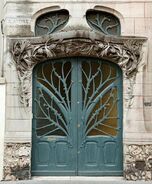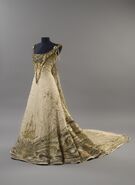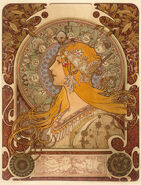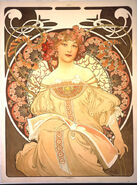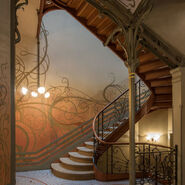No edit summary Tags: Visual edit Mobile edit |
Tag: Visual edit |
||
| (12 intermediate revisions by 4 users not shown) | |||
| Line 1: | Line 1: | ||
| − | {{Aesthetic|image1 = Art.jpeg|decade_of_origin = |
+ | {{Aesthetic|image1 = Art.jpeg|decade_of_origin = 1890s - 1910s|key_motifs=Flowing natural forms, flowers, lady|related_aesthetics=[[Art Academia]]<br>[[Romanticism]]<br>[[Romantic Academia]]<br>[[Vintage]]|other_names=Jugendstil, Stile Liberty, Modernismo}}'''Art Nouveau '''is an international style of art, architecture and applied art, especially the decorative arts. It was most popular between 1890 and 1910. |
It was a reaction to the academic art, eclecticism and historicism of 19th century architecture and decoration that favoured fine art, such as paintings and sculptures, over applied art. It was inspired by natural forms and structures, particularly the curved lines of plants and flowers, and whiplash forms. Other defining characteristics of Art Nouveau were a sense of dynamism and movement, often given by asymmetry and by curving lines, and the use of modern materials, such as iron pillars, sculpted and curved in naturalistic designs. Art Nouveau was known under the names of Jugdenstil in Germany, Nieuwe Kunst in the Netherlands, and Modern Style in Great Britain. It also inspired the psychedelic art of the 1960s. |
It was a reaction to the academic art, eclecticism and historicism of 19th century architecture and decoration that favoured fine art, such as paintings and sculptures, over applied art. It was inspired by natural forms and structures, particularly the curved lines of plants and flowers, and whiplash forms. Other defining characteristics of Art Nouveau were a sense of dynamism and movement, often given by asymmetry and by curving lines, and the use of modern materials, such as iron pillars, sculpted and curved in naturalistic designs. Art Nouveau was known under the names of Jugdenstil in Germany, Nieuwe Kunst in the Netherlands, and Modern Style in Great Britain. It also inspired the psychedelic art of the 1960s. |
||
| Line 27: | Line 27: | ||
==Gallery== |
==Gallery== |
||
| + | <gallery widths="185"> |
||
| ⚫ | |||
| ⚫ | |||
| − | [[File:Artam.jpg|thumb]] |
||
| + | Artam.jpg |
||
| ⚫ | |||
| ⚫ | |||
| − | + | Cc7050f83f9bd969cca68a4022582d7d.jpg |
|
| − | <br /> |
||
| + | Art_nouveau.jpg |
||
| + | Lady.jpg |
||
| + | Pretty_lady.jpg |
||
| + | Stair_s.jpg |
||
| + | Glorious.jpg |
||
| + | </gallery><br /> |
||
| + | |||
| + | === Pinterest Boards === |
||
| + | |||
| + | * [https://br.pinterest.com/silverz_/aesthetic/art-nouveau/ Aesthetic ♦︎ Art Nouveau ♦︎ by Silverz] |
||
| + | |||
[[Category:Visual]] |
[[Category:Visual]] |
||
| ⚫ | |||
[[Category:Art]] |
[[Category:Art]] |
||
| ⚫ | |||
Revision as of 23:03, 4 April 2021
Art Nouveau is an international style of art, architecture and applied art, especially the decorative arts. It was most popular between 1890 and 1910.
It was a reaction to the academic art, eclecticism and historicism of 19th century architecture and decoration that favoured fine art, such as paintings and sculptures, over applied art. It was inspired by natural forms and structures, particularly the curved lines of plants and flowers, and whiplash forms. Other defining characteristics of Art Nouveau were a sense of dynamism and movement, often given by asymmetry and by curving lines, and the use of modern materials, such as iron pillars, sculpted and curved in naturalistic designs. Art Nouveau was known under the names of Jugdenstil in Germany, Nieuwe Kunst in the Netherlands, and Modern Style in Great Britain. It also inspired the psychedelic art of the 1960s.
Visuals
- Vibrant colours such as greens, browns, yellows and gold
- Feminine figures
- Hand-lettering
- Plants such as cyclamen, iris, orchid, thistle, mistletoe, holly, water lily
- Animals such as swan, peacock, dragonfly and butterfly.
- Whiplash curves: asymmetrical, curved line in an S shape, frequently incorporated into natural forms such as women's hair and the stems of plants.
Artist
- Alphonse Mucha
- Gustav Klimt
- Antoni Gaudí
- Charles Rennie Mackintosh
- Émile Gallé
- René Lalique
- Aubrey Beardsley
- Henry van de Velde
- Victor Horta
- Louis Comfort Tiffany
- Hector Guimard
Gallery

